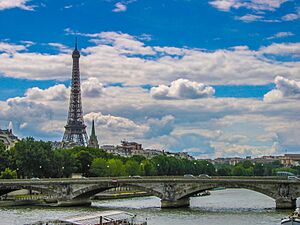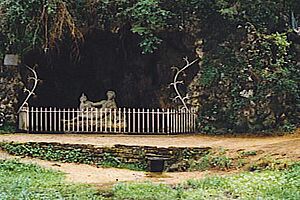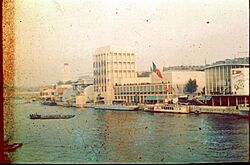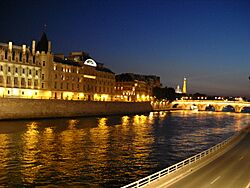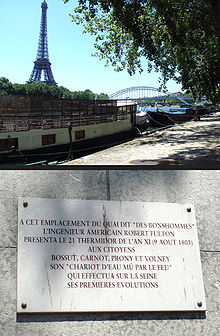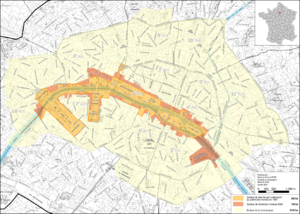Seine facts for kids
Quick facts for kids Seine |
|
|---|---|
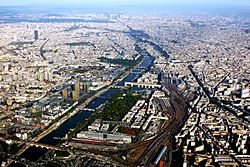
The Seine in Paris
|
|
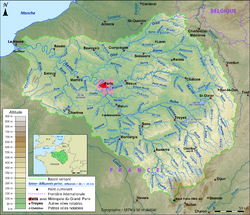
Topographic map of the Seine basin
|
|
| Country | France |
| Physical characteristics | |
| Main source | Source-Seine |
| River mouth | English Channel (French: la Manche) Le Havre/Honfleur 0 m (0 ft) 49°26′02″N 0°12′24″E / 49.43389°N 0.20667°E |
| Length | 777 km (483 mi) |
| Basin features | |
| River system | Seine basin |
| Basin size | 79,000 km2 (31,000 sq mi) |
| Tributaries | |
The Seine (/seɪn, sɛn/ sayn-,_-sen) is a 777-kilometre-long (483 mi) river in northern France. It flows through the famous city of Paris and empties into the English Channel near Le Havre.
The river is important for shipping. Large ships can travel as far as Rouen, which is about 120 kilometres (75 mi) from the sea. Smaller boats and tour boats can use most of the river's length. In Paris, special excursion boats called Bateaux Mouches offer tours to see the city's famous sights from the water.
There are 37 bridges in Paris that cross the Seine. Some of the most well-known are the Pont Alexandre III and the Pont Neuf. The very last bridge along the river's path is the Pont de Normandie. It is one of the longest cable-stayed bridges in the world and connects Le Havre with Honfleur.
Contents
River's Beginning
The Seine river starts in a place called Source-Seine, which is about 30 kilometres (19 mi) northwest of Dijon. The city of Paris has owned this area since 1864.
The source is made up of several small ditches that provide water. There's also an artificial cave built to highlight what is considered the main source. Inside this cave, you can find a statue of a nymph, a dog, and a dragon. Ancient Roman temple remains are also buried at this site. Small statues of the dea Sequana (the "Seine goddess") were found here and are now in the Dijon archaeological museum.
River's Journey
The Seine river's journey can be divided into five main parts:
- the Petite Seine, or "Small Seine," from its source to Montereau-Fault-Yonne.
- the Haute Seine, or "Upper Seine," from Montereau-Fault-Yonne to Paris.
- the Traversée de Paris, which is the part that flows through Paris.
- the Basse Seine, or "Lower Seine," from Paris to Rouen.
- the Seine maritime, or "Maritime Seine," from Rouen to the English Channel.
After Rouen, the river flows through a beautiful area called the Parc Naturel Régional des Boucles de la Seine Normande. This is a special nature park in France.
How Boats Use the Seine
The Seine is kept deep enough by dredging so that large ocean-going ships can reach Rouen. This city is 120 kilometres (75 mi) from the sea. Smaller commercial boats, like barges, can use the river starting from Marcilly-sur-Seine, which is 516 kilometres (321 mi) from the river's mouth.
In Paris, the river is only about 24 metres (79 ft) above sea level, even though it's 446 kilometres (277 mi) from the sea. This makes the river flow slowly, which is great for boats.
The "Maritime Seine" section, from the English Channel to Rouen, is the only part used by big ocean ships. After this, there are several large locks that help boats move up and down the river's different levels. These locks continue until the Oise river joins the Seine at Conflans-Sainte-Honorine. Smaller locks near Paris, at Bougival and Suresnes, lift boats to the river's level in the city.
The "Upper Seine" section, from Paris to Montereau-Fault-Yonne, is 98 km (61 mi) long and has 8 locks. The Marne river joins the Seine at Charenton-le-Pont. Further upstream from Paris, seven more locks help boats navigate to Saint Mammès, where the Loing river joins. Through an eighth lock, boats can reach the Yonne river at Montereau-Fault-Yonne.
From the Yonne river's mouth, larger ships can go upstream to Nogent-sur-Seine. From there, only small boats can travel to Marcilly-sur-Seine. A canal called the Canal de la Haute-Seine used to allow boats to go all the way to Troyes, but it has not been used since 1957.
Today, the Seine in Paris is about 9.5 meters (31 feet) deep. Before locks were built in the 1800s, the river was much shallower in the city. It had a small flowing channel with sandy banks. Now, the depth is carefully controlled, and the whole river width is usually full of water. The river's average flow is quite slow, but it can become much faster during heavy rains.
River Changes
In the 1960s, dredging work mostly removed the large waves, called "le mascaret," that used to occur on the lower part of the river due to tides.
Dams and Flood Control
Since 1950, four large reservoirs have been built on the Seine and its connecting rivers like the Yonne, Marne, and Aube. These reservoirs, including Lac d’Orient and Lake Der-Chantecoq, help keep the river's water level steady through Paris. However, they cannot completely stop the river from rising a lot during very heavy rainfall.
Flooding Events
In January 1910, there was a very serious flood that caused widespread flooding in Paris. The Seine also reached dangerous levels in 1924, 1955, 1982, 1999–2000, June 2016, and January 2018.
In 2003, after a flood warning, about 100,000 artworks were moved out of Paris. This was the biggest movement of art since World War II. Many artworks in Paris are stored in underground rooms that would have been flooded.
A report from 2002 by the French government estimated that a worst-case flood of the Seine could cost 10 billion euros. It also warned that it could cut off phone service for a million people in Paris and leave many without electricity or gas.
2018 Paris Flood
In January 2018, the Seine flooded again, reaching a level of 5.84 metres (19 ft 2 in) on January 29. An official warning was given on January 24 that heavy rain would likely cause the river to flood. By January 27, the river was rising. The Deputy Mayor of Paris, Colombe Brossel, said that the heavy rain was a sign of climate change. She explained that "climatic change is not a word, it's a reality."
River's Surroundings
The area drained by the Seine river, called its basin, covers 78,910 square kilometres (30,470 sq mi). About 2 percent of this area is forest, and 78 percent is farmland. Besides Paris, three other cities with over 100,000 people are in the Seine basin: Le Havre at the river's mouth, Rouen in the Seine valley, and Reims. The population density in this area is 201 people per square kilometer.
Rivers Joining the Seine
Many smaller rivers flow into the Seine. Here are some of its tributaries, listed from the source to the mouth:
- Ource (right side)
- Barse (right side)
- Aube (right side)
- Yonne (left side)
- Loing (left side)
- Almont (right side)
- Essonne (left side)
- Orge (left side)
- Yerres (right side)
- Marne (right side)
- Bièvre (left side)
- Oise (right side)
- Aubette de Meulan (right side)
- Mauldre (left side)
- Vaucouleurs (left side)
- Epte (right side)
- Andelle (right side)
- Eure (left side)
- Oison (left side)
- Aubette (right side)
- Cailly (right side)
- Austreberthe (right side)
- Commerce (right side)
- Risle (left side)
- Lézarde (right side)
Water Quality and Improvements
For a long time, the Seine river faced challenges with its water quality. This was due to industries, farms, and large cities like Paris releasing waste into it. The river had low oxygen levels and high amounts of pollution, especially from Paris to the sea. This problem lasted for over a century.
In the 1960s, new fertilizers used in farming increased pollution. Heavy industries near Paris also released untreated wastewater. Major French laws were passed in 1898, 1964, 1996, and 2006 to try and fix the water quality.
In the early 1900s, much of the city's sewage was used as fertilizer. But as cities grew, there was too much waste. Large wastewater treatment plants started to be built in 1940. However, by 1970, about 60% of city sewage still flowed into the river without treatment. This caused oxygen levels to drop, and the number of fish species in the river fell to just three.
Thanks to new rules and continued building of treatment plants in the 2000s, the water quality improved a lot. Pollution from organic carbon, phosphorus, and ammonia decreased. In 2009, it was exciting news that Atlantic salmon had returned to the Seine! By the early 2020s, the number of fish species near Paris had grown to 32.
Sometimes, during heavy rain, Paris's sewage system can overflow. This means untreated sewage might go into the Seine to prevent it from backing up into homes. This happens because Paris has an old drainage system that mixes street runoff with sewage. Even with these occasional issues, the water quality has greatly improved from what some historians once called an "open sewer."
In 1988, Jacques Chirac, who was then the mayor of Paris and later became president, first suggested lifting the swimming ban in the Seine. This ban had been in place since 1923 because of pollution. In 2018, a huge cleanup project called the "Swimming Plan" was started. It cost €1.4 billion (about $1.55 billion) and aimed to make the river safe for swimming by the 2024 Summer Olympics. This project included building a large basin to store rainwater, which is then slowly released into the sewer system to prevent overflows.
The plan also included creating several public swimming areas by 2025, ending the century-old ban. These efforts have shown good results, with the fish population growing from just two species to over 30. To show how clean the river had become, Mayor Anne Hidalgo and President Emmanuel Macron both promised to swim in the Seine. Mayor Hidalgo did so on July 17, 2024.
In July 2025, the Seine was officially reopened for swimming after being banned for almost 100 years.
History of the Seine
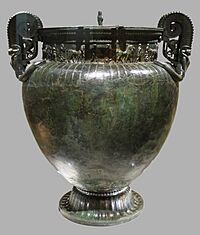
The name Seine comes from the old Gaullish word Sēquana. This name came from a Celtic goddess of the river, as people found offerings to her at the river's source.
In 845 AD, an army of Vikings led by a chieftain named Reginherus (possibly Ragnar Lothbrok) sailed up the Seine. They attacked and took over Paris. Later, in 885 AD, another Viking group led by Rollo also sailed up the Seine to attack Paris again.
In March 1314, King Philip IV of France had Jacques de Molay, the last leader of the Knights Templar, burned on a platform on an island in the Seine in front of Notre Dame de Paris.
After Joan of Arc was burned in 1431, her ashes were thrown into the Seine from the Mathilde Bridge in Rouen.
On August 9, 1803, Robert Fulton, an American inventor, successfully tested his steamboat in the Seine near the Tuileries Garden. His steamboat was sixty-six feet long and could travel at speeds of three to four miles per hour against the river's current.
During World War II in 1944, reaching the Seine was a key goal for the Allies in Operation Overlord. They aimed to reach the river within 90 days of D-Day, and they succeeded. Although a major river crossing battle was expected, German resistance in France collapsed, and it didn't happen. However, the First Canadian Army did fight west of the Seine to stop German soldiers from escaping across the river during the end of the Battle of Normandy.
Some Algerian people who were victims of the 1961 Paris massacre drowned in the Seine. They were thrown into the river by French police from the Pont Saint-Michel and other places in Paris.
The Seine at the Olympics
1900 and 1924 Summer Olympics
The Seine river was used for events during the 1900 Summer Olympics. It hosted rowing, swimming, and water polo. Twenty-four years later, for the 1924 Summer Olympics, the river again hosted the rowing events at Bassin d'Argenteuil, north of Paris.
2024 Summer Olympics
More than a century later, the Seine played a big role in the 2024 Summer Olympics. It hosted a boat parade for the opening ceremony, with boats for each country's team.
The river was also the location for the men's and women's marathon swimming events and the swimming part of the triathlon. Even though swimming in the Seine had been banned since 1923, a €1.4 billion cleanup project aimed to make the water safe. During the Olympics, daily tests were done to check the water quality. This caused the triathlon to be delayed by a day, but it went ahead on July 31. A few triathletes felt sick afterward, but it was not clear if the Seine water was the cause.
World Heritage Site
In 1991, UNESCO added the banks of the Seine in Paris to its list of World Heritage Sites in Europe. This means the area is considered very important and special for everyone to protect. The boundaries of this site were updated in 2024.
The Seine in Art
The Seine river has inspired many artists, especially in the 19th and 20th centuries. Some famous artists who painted the Seine include:
- Frédéric Bazille
- Maurice Boitel
- Richard Parkes Bonington
- Eugène Boudin
- Camille Corot
- Charles-François Daubigny
- Guy Debord
- Raoul Dufy
- Othon Friesz
- Carl Fredrik Hill
- Eugène Isabey
- Johan Jongkind
- Raimond Lecourt
- Albert Marquet
- Henri Matisse
- Claude Monet
- Luis F. Pinzón
- Camille Pissarro
- Emilio Grau Sala
- Gaston Sébire
- Georges Seurat
- Alfred Sisley
- Constant Troyon
- J. M. W. Turner
- Félix Vallotton
- Édouard Vuillard
- Pierre-Auguste Renoir
There are also songs about the Seine. "La Seine" by Flavien Monod and Guy Lafarge was written in 1948. Josephine Baker also recorded a song called "La Seine." Another song titled "La Seine," by Vanessa Paradis featuring Matthieu Chedid, was part of the movie A Monster in Paris (2011). The Seine is also mentioned in ABBA's 1980 song "Our Last Summer."
Images for kids
-
Alfred Sisley, The Terrace at Saint-Germain, Spring (1875) in the Walters Art Museum gives a panoramic view of the Seine river valley.
See also
 In Spanish: Río Sena para niños
In Spanish: Río Sena para niños
- List of crossings of the Seine
- EPTB Seine Grands Lacs


